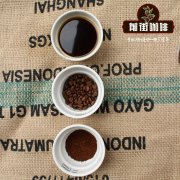Coffee roasting development knowledge of coffee how to roast coffee

Professional coffee knowledge exchange more coffee bean information please follow the coffee workshop (Wechat official account cafe_style)
Roasted coffee transforms the chemical and physical properties of raw coffee beans into roasted coffee products. The roasting process causes raw beans to expand and change their color, taste, smell and density, resulting in the special flavor of coffee. Unroasted coffee beans and roasted coffee beans contain similar acidity, protein and caffeine, but lack their good taste. The process needs to be hot enough to accelerate Maillard's reaction with other chemical reactions that add flavor.
As raw coffee beans are much more stable than roasted coffee beans, the roasting process tends to take place near the consumer market. This reduces the delivery time of roasted coffee beans and maximizes the shelf life of coffee beans. The vast majority of coffee beans are roasted commercially on a large scale, but some coffee drinkers bake their own beans in order to accurately control their freshness and taste.
★ coffee roasting stage
Steaming stage: 00-10 minutes; free beans-140C ° This is the most important process of the endothermic reaction of coffee beans, at this stage, the beans will slowly expand, the color will change from green to white, and the moisture will slowly evaporate from the heart of the beans because of the heat absorption of the beans. Whether the coffee tastes good or not depends on this stage, when the water evaporates too quickly, it is easy to cause the bean heart to be unripe, the beans easy to be bitter, and when the water evaporates too slowly, it will cause the coffee to taste insipid. The aroma is not rich. Therefore, we insist that the steaming process must not be omitted, and we should also use this process to make the coffee more fragrant, stronger and tastier.
Dehydration stage (before explosion): 10-15 minutes; 140-180C °; at the end of steaming, the coffee beans will change from white to yellowish light brown, when the coffee beans will continue to absorb heat to reach an explosion, and the coffee beans will expand from steaming to shrink dehydration. At this time, the moisture of the coffee beans will decrease rapidly, and when the heat absorption reaches the extreme point of the coffee itself, there will be an explosive reaction, which is called an explosion.
The first explosion stage (before the end of the first explosion): 15-18 minutes; 180-210 C °; after the first explosion, the coffee bean will begin to give back exactly the right heat you gave it, showing a perfect exothermic reaction, and then we can obviously smell it. The aroma of coffee will change from grass to coffee coke, and with the progress of the explosion, the coffee beans will burst and expand. From this time to the time when the coffee is charred, basically all the coffee can be drunk without the taste of grass, but the coffee at the beginning of the explosion will be very sour and not bitter. With the passage of time, the taste of coffee will turn into non-sour and extremely bitter. Generally speaking, the bean point will be determined by the flavor of the coffee itself. when the sour taste is fast and the bitter taste is about to appear, this is usually the bean spot. At this time, the sweetness of the coffee under the beans will reach its peak, and the flavor will be optimized. This point depends on the flavor of the coffee itself. due to the difference in growth environment, climate, soil, and moisture, the flavor of coffee will be slightly different. In this link, we should keep this point within our ideal range and keep it stable.
Second explosion stage: 18-20 minutes; 210 mi C °under the bean After the first burst, the coffee bean will slowly mature and emit a charming aroma, and when the heat absorption reaches the second peak again, the coffee bean will have a second explosion, the so-called second explosion, which will open up a space in the heart of the epidermis, and the carbon dioxide in the coffee bean will continue to be discharged, causing the internal temperature to rise continuously, start coking, turn into oil, and ooze out of the coffee surface. At this time, the coffee flavor will be bitter, strong flavor, usually Starbucks is baked to this stage, and then continue, the coffee beans will slowly turn into coke, except for the bitter taste without any flavor. This kind of coffee is lifeless, and this is a perfect performance of coffee beans.
Important Notice :
前街咖啡 FrontStreet Coffee has moved to new addredd:
FrontStreet Coffee Address: 315,Donghua East Road,GuangZhou
Tel:020 38364473
- Prev

Coffee roasting and Flavor [II] Coffee roasting Coffee Flavor Light Coffee lack of Baking Flavor
Professional coffee knowledge exchange more coffee bean information please pay attention to coffee workshop (Wechat official account cafe_style) Coffee roasting to put it simply is to roast raw beans, cooked and roasted thoroughly, the definition will vary according to everyone's subjective preferences. So the final roasted coffee beans will have a lot of unpredictable disadvantages. And the common bitterness and astringency in baking or
- Next

Knowledge of coffee roasting development [2] Coffee roasting process coffee roasting development time ratio
Professional coffee knowledge exchange more coffee bean information please follow the coffee workshop (Wechat official account cafe_style), and the way of baking can be simply divided into two ways: firepower and hot air. Different baking degrees will also bring different tastes, and this is the most interesting part of baking. In addition to baking, professional baristas are more concerned about how well the baked beans should be ripe.
Related
- Beginners will see the "Coffee pull flower" guide!
- What is the difference between ice blog purified milk and ordinary milk coffee?
- Why is the Philippines the largest producer of crops in Liberia?
- For coffee extraction, should the fine powder be retained?
- How does extracted espresso fill pressed powder? How much strength does it take to press the powder?
- How to make jasmine cold extract coffee? Is the jasmine + latte good?
- Will this little toy really make the coffee taste better? How does Lily Drip affect coffee extraction?
- Will the action of slapping the filter cup also affect coffee extraction?
- What's the difference between powder-to-water ratio and powder-to-liquid ratio?
- What is the Ethiopian local species? What does it have to do with Heirloom native species?

